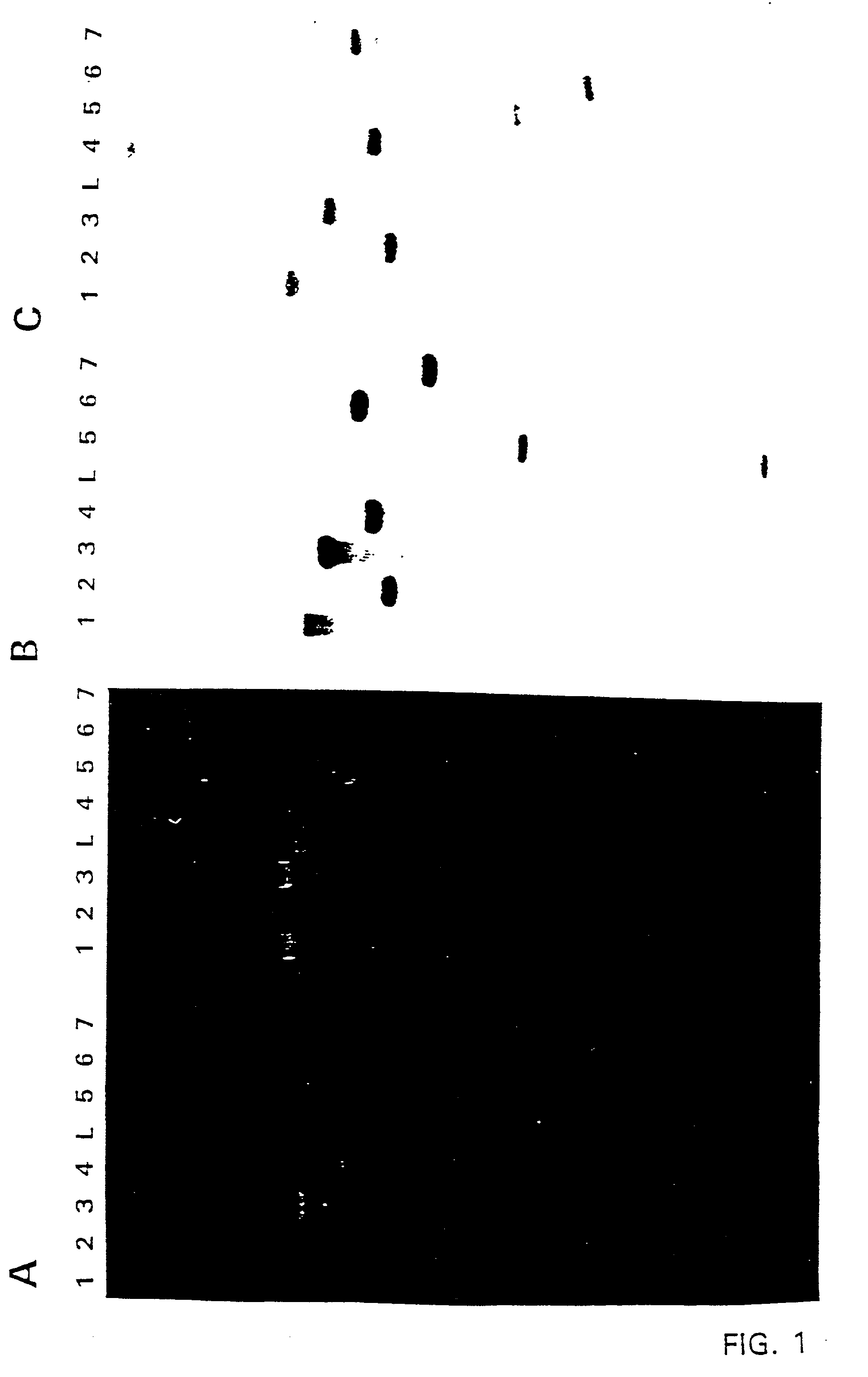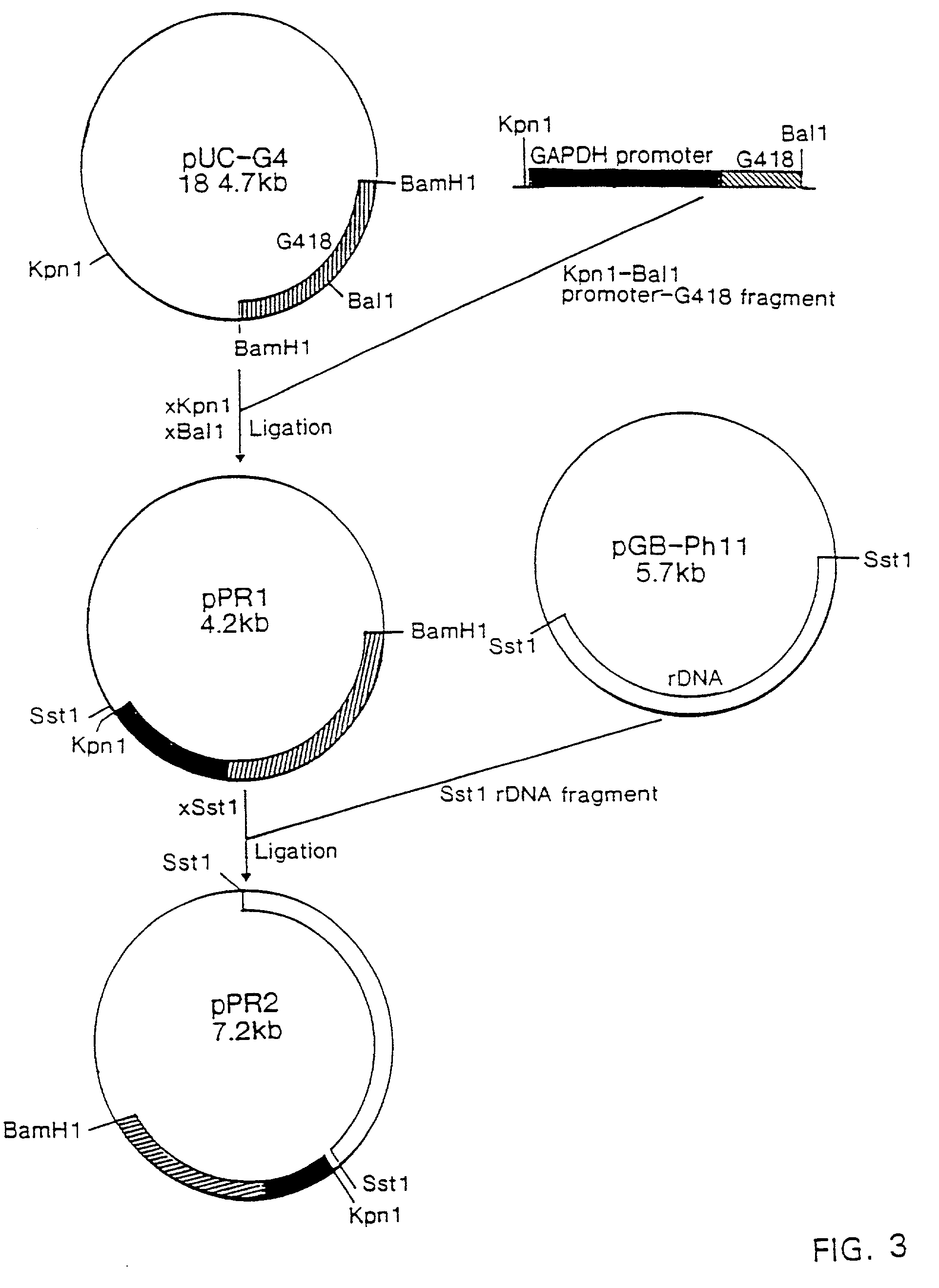Recombinant materials for carotenoid production
a technology of recombinant materials and carotenoid, which is applied in the direction of enzymology, peptides, transferases, etc., can solve the problem of increasing the level of astaxanthin
- Summary
- Abstract
- Description
- Claims
- Application Information
AI Technical Summary
Benefits of technology
Problems solved by technology
Method used
Image
Examples
example 2
[0143] Synthesis of Specific Probes of Glycolytic genes from Phaffia rhodozyma by PCR
[0144] The polymerase chain reaction (PCR) technique was used in an attempt to synthesize a homologous probe of the genes encoding glyceraldehyde-3-phosphate dehydrogenase (GAPDH), phosphoglycerate kinase (PGK) and the triose phosphate isomerase (TPI) of Phaffia rhodozyma.
[0145] A set of degenerated oligonucleotides was designed based on the conserved regions in the GAPDH-gene (Michels et al., 1986. EMBO J. 5: 1049-1056), PGK-gene (Osinga et al., 1985. EMBO J. 4: 3811-3817) and the TPI-gene (Swinkels et al., 1986. EMBO J. 5: 1291-1298).
[0146] All possible oligo combinations were used to synthesize a PCR-fragment with chromosomal DNA of Phaffia rhodozyma (strain CBS6938) as template. Chromosomal DNA of Saccharomyces cerevisiae and Kluyveromyces lactis as template was used to monitor the specificity of the amplification. The PCR was performed as described above, the PCR conditions were 1' 95.degree. C...
example 3
Isolation of the GAPDH-Gene of Phaffia
[0150] To obtain the complete GAPDH-gene including expression signals the 0.3-kb BamHI fragment of pPRGDH1 was used to screen a cosmid library of Phaffia.
[0151] Preparation of the Vector for Cosmid Cloning.
[0152] Vector preparation was simplified, because of the presence of a double cos-site in pMT6. PMT6 was digested to completion with blunt end cutter PvuII to release the cos-sites. Digestion efficiency was checked by transformation to E. coli DH5.alpha. and found to be >99%.
[0153] The PvuII digested pMT6 was purified by phenol:chloroform extraction and ethanol precipitation and finally solved in 30 .mu.l TE at a concentration of 2 .mu.g / .mu.l.
[0154] The vector was subsequently digested with cloning enzyme BamHI and the vector arms were purified as described above ("Experimental").
[0155] Preparation of Target DNA
[0156] Isolation of genomic DNA of Phaffia strain CBS6938 was performed as described in the part named "Experimental". The cosmid pMT...
example 4
Characterization of the GAPDH-gene
[0165] In order to carry out sequence analysis without the need to synthesize a number of specific sequence primers a number of deletion constructs of plasmids pPRGDH3 and pPRGDH6 were made using convenient restriction sites in or near the putative coding region of GAPDH gene.
[0166] The plasmids were digested and after incubation a sample of the restriction mixture was analyzed by gel electrophoresis to monitor complete digestion. After extraction with phenol-chloroform the DNA was precipitated by ethanol. After incubation at -20.degree. C. for 30' the DNA is pelleted by centrifugation, dried and dissolved in a large volume (0.1 ng / .mu.l) of TE. After ligation the mixtures were transformed to E. coli. Plasmid DNA isolated from these transformants was analyzed by restriction analysis to reveal the right constructs. In this way the deletion constructs pPRGDH3.delta.HIII, pPRGDH6.delta.BamHI, pPRGDH6.delta.SstI and pPRGDH6.delta.SalI (FIG. 1).
[0167] In...
PUM
| Property | Measurement | Unit |
|---|---|---|
| temperature | aaaaa | aaaaa |
| temperature | aaaaa | aaaaa |
| Exposure time | aaaaa | aaaaa |
Abstract
Description
Claims
Application Information
 Login to View More
Login to View More - R&D
- Intellectual Property
- Life Sciences
- Materials
- Tech Scout
- Unparalleled Data Quality
- Higher Quality Content
- 60% Fewer Hallucinations
Browse by: Latest US Patents, China's latest patents, Technical Efficacy Thesaurus, Application Domain, Technology Topic, Popular Technical Reports.
© 2025 PatSnap. All rights reserved.Legal|Privacy policy|Modern Slavery Act Transparency Statement|Sitemap|About US| Contact US: help@patsnap.com



